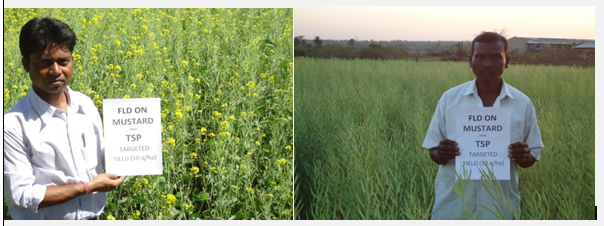Authors: Sunanda Biswas1*, A. R. Saha2, S. P. Mazumdar2 and B. Majumdar2
1Division of Soil Science and Agricultural Chemistry, ICAR-IARI, New Delhi-110012
2Crop Production Division, ICAR-CRIJAF, Barrackpore, West Bengal
*Corresponding author, email: sunandabiswas13@gmail.com
Mustard is one of the most important edible oilseed crops in West Bengal. When compared to other edible oils it has the lowest amount of harmful saturated fatty acids. It is grown as rabi crop in winter after harvesting of aman paddy with little shower preceeding sowing. Mustard can be also grown as rainfed crop in areas having no irrigation facility.
Front line demonstration on soil test and targeted yield based fertilizer application on mustard was conducted in farmers’ field under tribal sup plan in the three blocks of Bankura district. Targeted yield equation of mustard (B-9) as developed by CRIJAF used for application of fertilizers to achieving targeted yield of mustard (10 q ha-1) in rainfed conditions. Targeted yield equations used for conduction of front line demonstration on mustard (B9) in farmer’s field
FN = 16.5 T â€" 0.08 SN
FP = 4.66 T â€" 0.41 SP
FK = 5.71 T â€" 0.03 SK
The villages viz. Hanumanhir, Saresh, Daldali, Bamundia, Majharpara and Bharatpur under three blocks in Bankura districts were selected for frontline demonstration on mustard showed variation in successful area, net return and profit. Ten front line demonstrations were conducted in village-Hanumanhir, Grampanchyte-Nakaijuri, Block-Onda in which 16 bigha (2.13 ha) area were covered, out of which 15 bigha (2.0 ha) area showed successful area. Overall under this scheme, 111 farmers were participated and covering 24.8 ha area, out of which 21.9 ha area recorded as successful area in which proper germination and seeds maturation were observed. Application of fertilizers as per soil test and targeted yield basis could not achieve targeted grain yield (10 q ha-1) of mustard (var. B-9) within ±10% yield deviation in Bankura district. However, grain yield of mustard (mean basis) recorded from each block clearly indicate that application of fertilizers as per soil test and targeted yield basis apparently superior over farmers practice. The highest grain yield (7.05 q ha-1), response ratio (2.04 kg kg-1) and net return (Rs. 6165 ha-1) was recorded in Bharatpur village followed by Majharpara (6.58 q ha-1). The lowest grain yield (5.71 q ha-1) was recorded both in targeted yield equation and farmers practice (3.14 q ha-1) treatment in Daldali Village.
Table 1. Effect of fertilizers application as per soil test and targeted yield on yield and net return of mustard at different blocks of Bankura district (means of all block)
| S. No. | Name of Village | No. of farmers | Total area (ha) | Success area (ha) | Targeted grain yield (q ha-1) | Farmers practice yield (q ha-1) | Resp. Ratio (kg kg NPK-1) | Profit due to fertilizers (Rs. ha-1) | |
| 1. | Village-Hanumanhir Block-Onda | 10 | 2.13 | 2.00 | 6.30 | 3.48 | 1.77 | 5045 | |
| 2. | Village-SareshKanali Block-Onda | 35 | 10.8 | 9.00 | 5.97 | 3.19 | 1.69 | 4607 | |
| 3. | Village-Daldali Block-Onda | 15 | 2.40 | 2.27 | 5.71 | 3.14 | 1.60 | 4038 | |
| 4. | Village-Majharpra Block-Onda | 15 | 3.73 | 3.20 | 6.58 | 3.44 | 1.99 | 6055 | |
| 5. | Village-Bharatpur Block-Chhatna | 14 | 2.40 | 2.4 | 7.03 | 3.69 | 2.04 | 6165 | |
| 6. | Village-Bamundia Block-G.Ghati | 22 | 3.33 | 3.06 | 6.27 | 3.83 | 1.50 | 3443 |

Plate: Showing response of fertilizers application based on soil test and targeted yield of mustard
It is concluded that soil test and targeted yield based fertilizers application is superior as compared to farmers practice getting higher yield but to achieve target yield of mustard irrigation water is needed.
About Author / Additional Info:
WORKING AS A SCIENTIST IN ICAR-IARI